Microbiology Report on Corona Virus, SARS, and COVID-19 - PHI 203
VerifiedAdded on 2023/05/12
|10
|2230
|208
Report
AI Summary
This report provides a detailed overview of coronaviruses, including SARS and COVID-19, focusing on their identification, classification, and pathogenesis. It discusses the mechanisms of infection, highlighting the three phases: virus replication, immune system hyperactivity, and pulmonary cell destruction. The report also addresses diagnostic methods, emphasizing the limitations of clinical distinctions and the utility of laboratory tests such as ELISA and PCR. Prevention strategies, including education campaigns, hygiene practices, and government measures like travel restrictions and quarantine protocols, are outlined. Treatment options, ranging from symptomatic support to antiviral drugs and potential Chinese herbal medicine approaches, are also explored. Furthermore, the report delves into the specifics of SARS, covering its signs and symptoms, diagnostic criteria, and preventive measures, as well as COVID-19, including its variable symptoms, transmission routes, diagnostic methods, and current treatment strategies. The report concludes by emphasizing the importance of precautionary measures and ongoing research for vaccine development and disease management. Desklib offers students access to similar solved assignments and past papers for comprehensive study support.
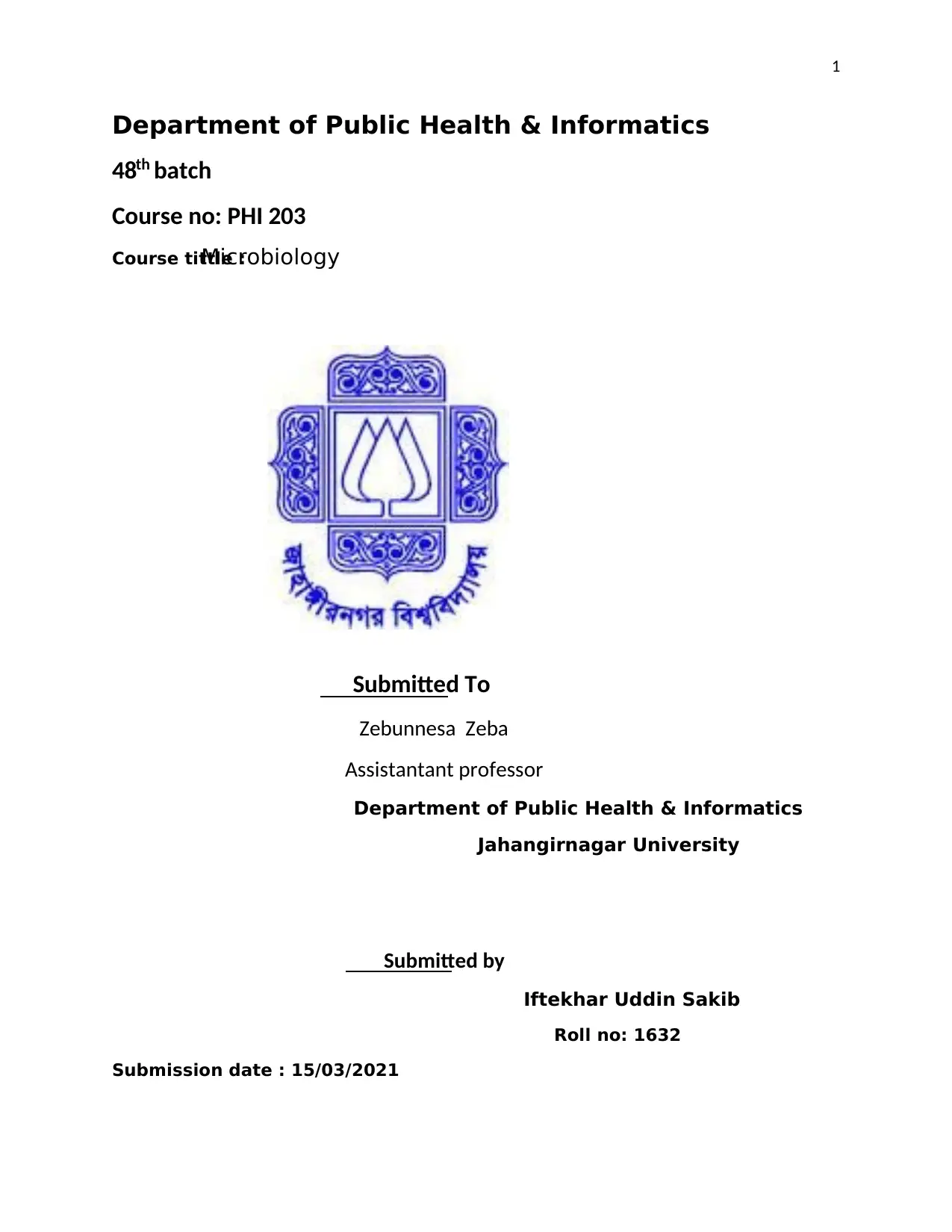
1
Department of Public Health & Informatics
48th batch
Course no: PHI 203
Course tittle :Microbiology
Submitted To
Zebunnesa Zeba
Assistantant professor
Department of Public Health & Informatics
Jahangirnagar University
Submitted by
Iftekhar Uddin Sakib
Roll no: 1632
Submission date : 15/03/2021
Department of Public Health & Informatics
48th batch
Course no: PHI 203
Course tittle :Microbiology
Submitted To
Zebunnesa Zeba
Assistantant professor
Department of Public Health & Informatics
Jahangirnagar University
Submitted by
Iftekhar Uddin Sakib
Roll no: 1632
Submission date : 15/03/2021
Paraphrase This Document
Need a fresh take? Get an instant paraphrase of this document with our AI Paraphraser
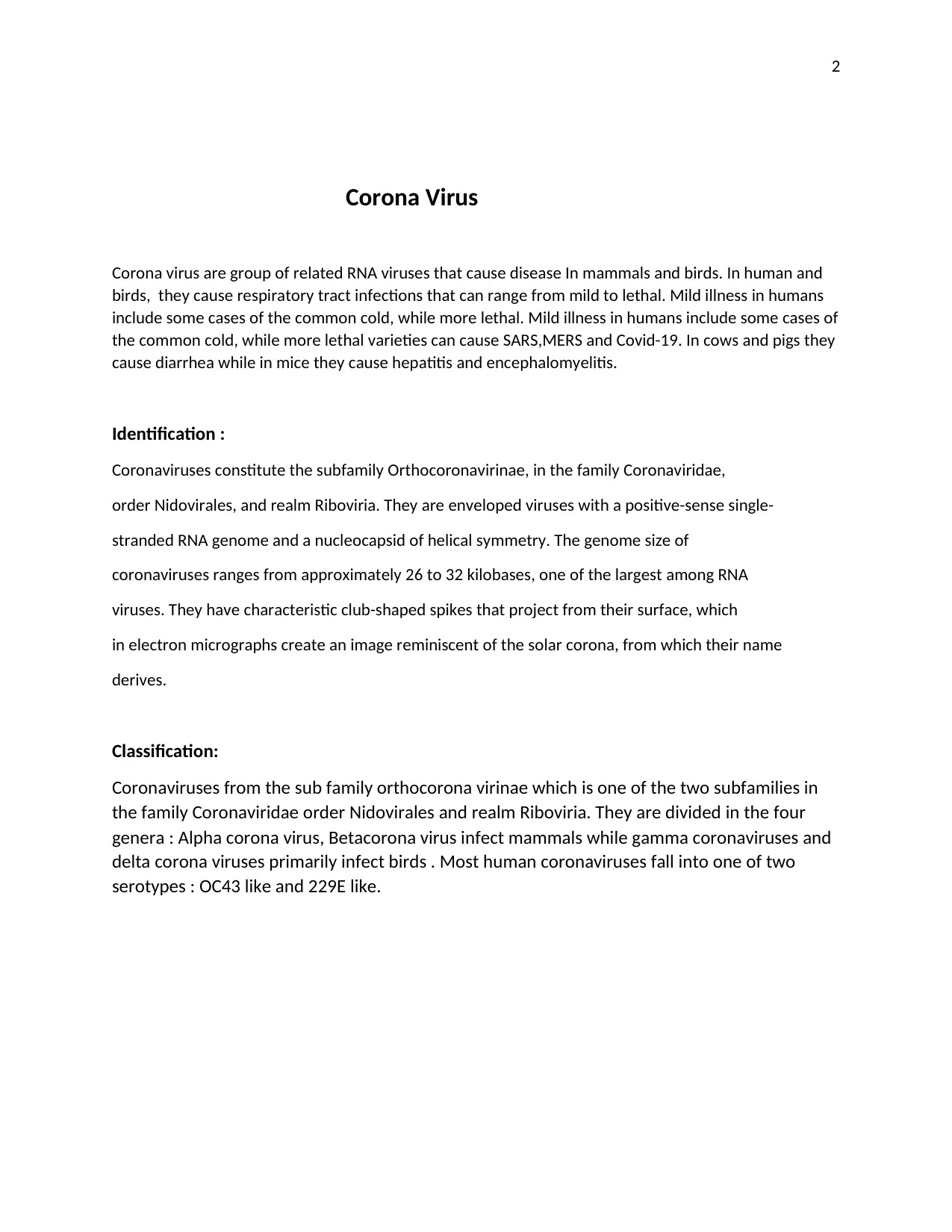
2
Corona Virus
Corona virus are group of related RNA viruses that cause disease In mammals and birds. In human and
birds, they cause respiratory tract infections that can range from mild to lethal. Mild illness in humans
include some cases of the common cold, while more lethal. Mild illness in humans include some cases of
the common cold, while more lethal varieties can cause SARS,MERS and Covid-19. In cows and pigs they
cause diarrhea while in mice they cause hepatitis and encephalomyelitis.
Identification :
Coronaviruses constitute the subfamily Orthocoronavirinae, in the family Coronaviridae,
order Nidovirales, and realm Riboviria. They are enveloped viruses with a positive-sense single-
stranded RNA genome and a nucleocapsid of helical symmetry. The genome size of
coronaviruses ranges from approximately 26 to 32 kilobases, one of the largest among RNA
viruses. They have characteristic club-shaped spikes that project from their surface, which
in electron micrographs create an image reminiscent of the solar corona, from which their name
derives.
Classification:
Coronaviruses from the sub family orthocorona virinae which is one of the two subfamilies in
the family Coronaviridae order Nidovirales and realm Riboviria. They are divided in the four
genera : Alpha corona virus, Betacorona virus infect mammals while gamma coronaviruses and
delta corona viruses primarily infect birds . Most human coronaviruses fall into one of two
serotypes : OC43 like and 229E like.
Corona Virus
Corona virus are group of related RNA viruses that cause disease In mammals and birds. In human and
birds, they cause respiratory tract infections that can range from mild to lethal. Mild illness in humans
include some cases of the common cold, while more lethal. Mild illness in humans include some cases of
the common cold, while more lethal varieties can cause SARS,MERS and Covid-19. In cows and pigs they
cause diarrhea while in mice they cause hepatitis and encephalomyelitis.
Identification :
Coronaviruses constitute the subfamily Orthocoronavirinae, in the family Coronaviridae,
order Nidovirales, and realm Riboviria. They are enveloped viruses with a positive-sense single-
stranded RNA genome and a nucleocapsid of helical symmetry. The genome size of
coronaviruses ranges from approximately 26 to 32 kilobases, one of the largest among RNA
viruses. They have characteristic club-shaped spikes that project from their surface, which
in electron micrographs create an image reminiscent of the solar corona, from which their name
derives.
Classification:
Coronaviruses from the sub family orthocorona virinae which is one of the two subfamilies in
the family Coronaviridae order Nidovirales and realm Riboviria. They are divided in the four
genera : Alpha corona virus, Betacorona virus infect mammals while gamma coronaviruses and
delta corona viruses primarily infect birds . Most human coronaviruses fall into one of two
serotypes : OC43 like and 229E like.
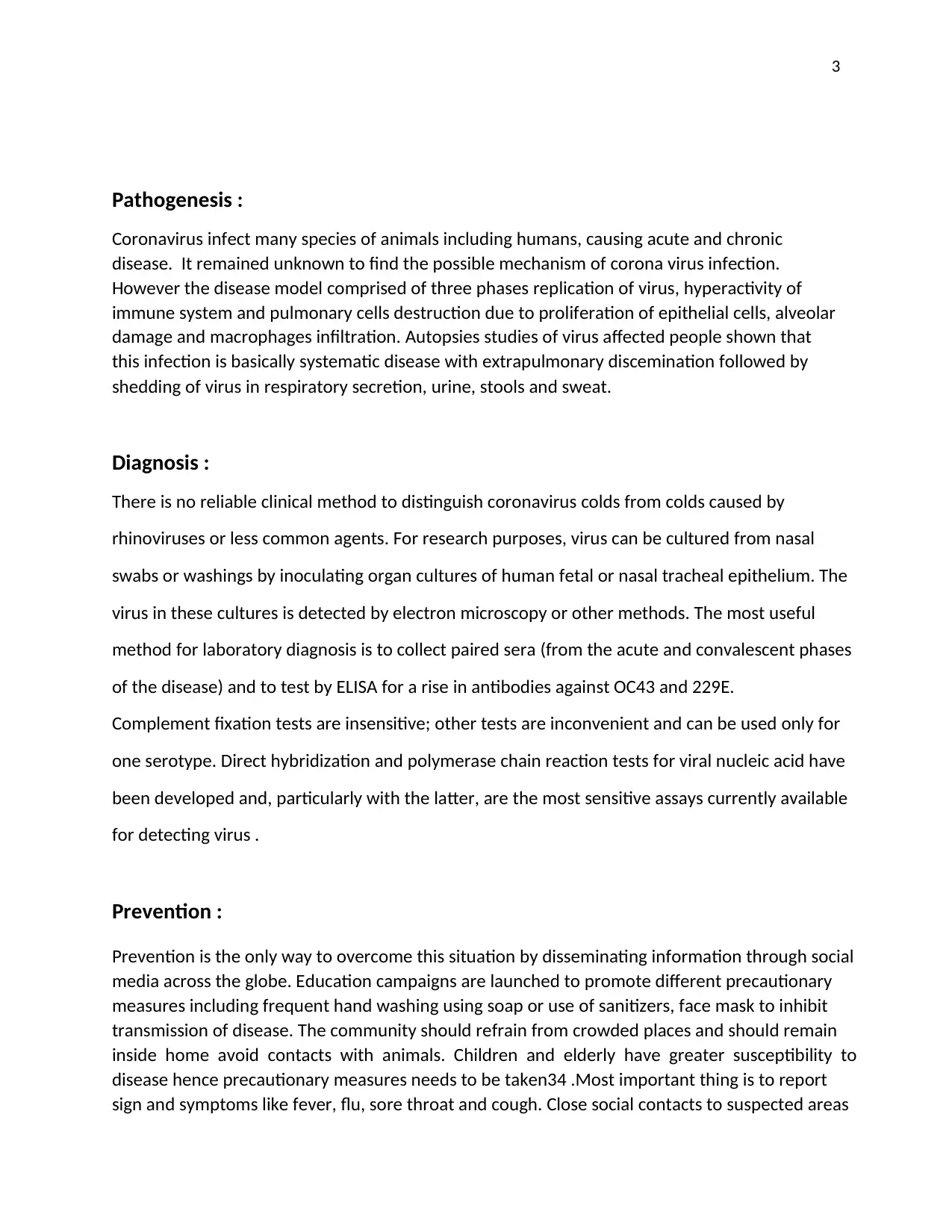
3
Pathogenesis :
Coronavirus infect many species of animals including humans, causing acute and chronic
disease. It remained unknown to find the possible mechanism of corona virus infection.
However the disease model comprised of three phases replication of virus, hyperactivity of
immune system and pulmonary cells destruction due to proliferation of epithelial cells, alveolar
damage and macrophages infiltration. Autopsies studies of virus affected people shown that
this infection is basically systematic disease with extrapulmonary discemination followed by
shedding of virus in respiratory secretion, urine, stools and sweat.
Diagnosis :
There is no reliable clinical method to distinguish coronavirus colds from colds caused by
rhinoviruses or less common agents. For research purposes, virus can be cultured from nasal
swabs or washings by inoculating organ cultures of human fetal or nasal tracheal epithelium. The
virus in these cultures is detected by electron microscopy or other methods. The most useful
method for laboratory diagnosis is to collect paired sera (from the acute and convalescent phases
of the disease) and to test by ELISA for a rise in antibodies against OC43 and 229E.
Complement fixation tests are insensitive; other tests are inconvenient and can be used only for
one serotype. Direct hybridization and polymerase chain reaction tests for viral nucleic acid have
been developed and, particularly with the latter, are the most sensitive assays currently available
for detecting virus .
Prevention :
Prevention is the only way to overcome this situation by disseminating information through social
media across the globe. Education campaigns are launched to promote different precautionary
measures including frequent hand washing using soap or use of sanitizers, face mask to inhibit
transmission of disease. The community should refrain from crowded places and should remain
inside home avoid contacts with animals. Children and elderly have greater susceptibility to
disease hence precautionary measures needs to be taken34 .Most important thing is to report
sign and symptoms like fever, flu, sore throat and cough. Close social contacts to suspected areas
Pathogenesis :
Coronavirus infect many species of animals including humans, causing acute and chronic
disease. It remained unknown to find the possible mechanism of corona virus infection.
However the disease model comprised of three phases replication of virus, hyperactivity of
immune system and pulmonary cells destruction due to proliferation of epithelial cells, alveolar
damage and macrophages infiltration. Autopsies studies of virus affected people shown that
this infection is basically systematic disease with extrapulmonary discemination followed by
shedding of virus in respiratory secretion, urine, stools and sweat.
Diagnosis :
There is no reliable clinical method to distinguish coronavirus colds from colds caused by
rhinoviruses or less common agents. For research purposes, virus can be cultured from nasal
swabs or washings by inoculating organ cultures of human fetal or nasal tracheal epithelium. The
virus in these cultures is detected by electron microscopy or other methods. The most useful
method for laboratory diagnosis is to collect paired sera (from the acute and convalescent phases
of the disease) and to test by ELISA for a rise in antibodies against OC43 and 229E.
Complement fixation tests are insensitive; other tests are inconvenient and can be used only for
one serotype. Direct hybridization and polymerase chain reaction tests for viral nucleic acid have
been developed and, particularly with the latter, are the most sensitive assays currently available
for detecting virus .
Prevention :
Prevention is the only way to overcome this situation by disseminating information through social
media across the globe. Education campaigns are launched to promote different precautionary
measures including frequent hand washing using soap or use of sanitizers, face mask to inhibit
transmission of disease. The community should refrain from crowded places and should remain
inside home avoid contacts with animals. Children and elderly have greater susceptibility to
disease hence precautionary measures needs to be taken34 .Most important thing is to report
sign and symptoms like fever, flu, sore throat and cough. Close social contacts to suspected areas
⊘ This is a preview!⊘
Do you want full access?
Subscribe today to unlock all pages.

Trusted by 1+ million students worldwide
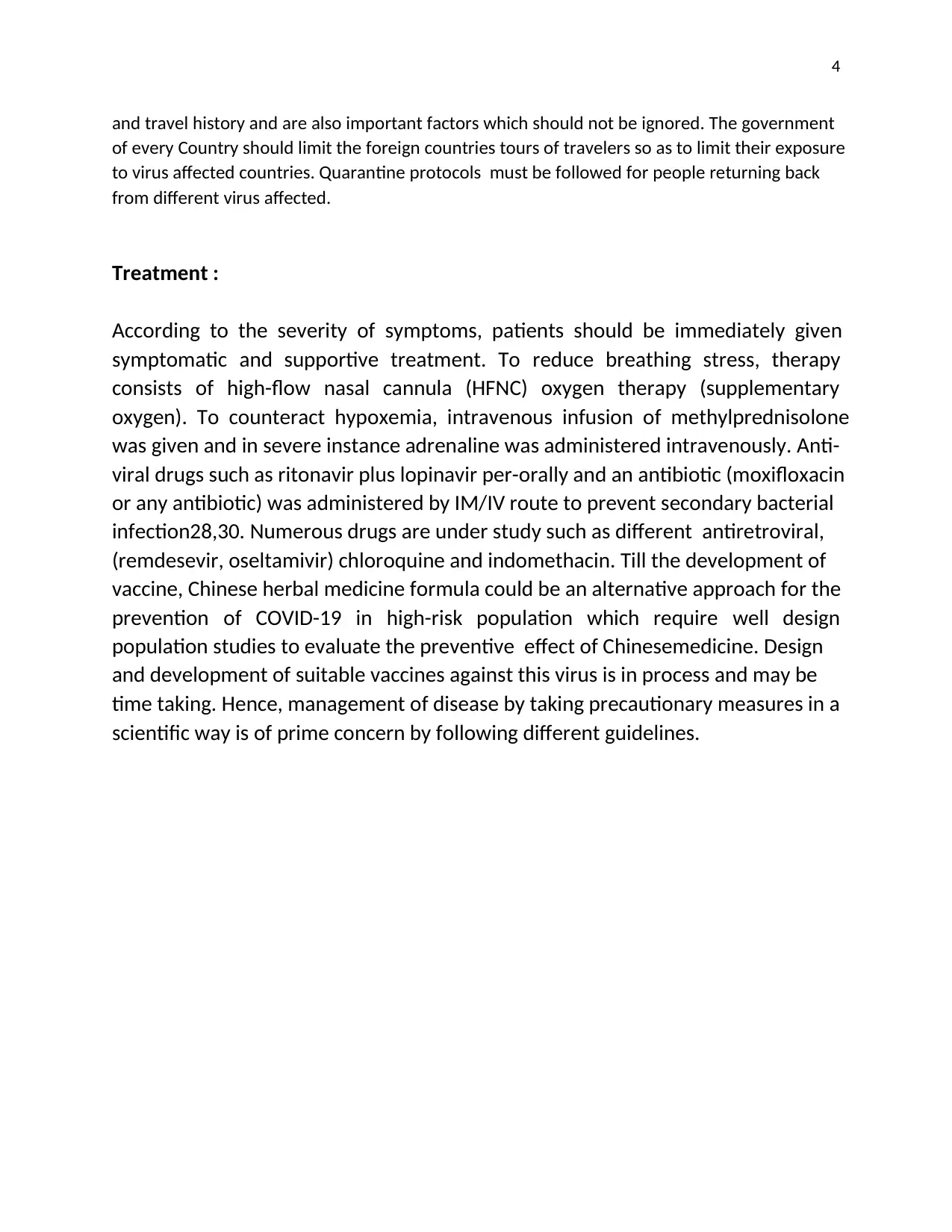
4
and travel history and are also important factors which should not be ignored. The government
of every Country should limit the foreign countries tours of travelers so as to limit their exposure
to virus affected countries. Quarantine protocols must be followed for people returning back
from different virus affected.
Treatment :
According to the severity of symptoms, patients should be immediately given
symptomatic and supportive treatment. To reduce breathing stress, therapy
consists of high-flow nasal cannula (HFNC) oxygen therapy (supplementary
oxygen). To counteract hypoxemia, intravenous infusion of methylprednisolone
was given and in severe instance adrenaline was administered intravenously. Anti-
viral drugs such as ritonavir plus lopinavir per-orally and an antibiotic (moxifloxacin
or any antibiotic) was administered by IM/IV route to prevent secondary bacterial
infection28,30. Numerous drugs are under study such as different antiretroviral,
(remdesevir, oseltamivir) chloroquine and indomethacin. Till the development of
vaccine, Chinese herbal medicine formula could be an alternative approach for the
prevention of COVID-19 in high-risk population which require well design
population studies to evaluate the preventive effect of Chinesemedicine. Design
and development of suitable vaccines against this virus is in process and may be
time taking. Hence, management of disease by taking precautionary measures in a
scientific way is of prime concern by following different guidelines.
and travel history and are also important factors which should not be ignored. The government
of every Country should limit the foreign countries tours of travelers so as to limit their exposure
to virus affected countries. Quarantine protocols must be followed for people returning back
from different virus affected.
Treatment :
According to the severity of symptoms, patients should be immediately given
symptomatic and supportive treatment. To reduce breathing stress, therapy
consists of high-flow nasal cannula (HFNC) oxygen therapy (supplementary
oxygen). To counteract hypoxemia, intravenous infusion of methylprednisolone
was given and in severe instance adrenaline was administered intravenously. Anti-
viral drugs such as ritonavir plus lopinavir per-orally and an antibiotic (moxifloxacin
or any antibiotic) was administered by IM/IV route to prevent secondary bacterial
infection28,30. Numerous drugs are under study such as different antiretroviral,
(remdesevir, oseltamivir) chloroquine and indomethacin. Till the development of
vaccine, Chinese herbal medicine formula could be an alternative approach for the
prevention of COVID-19 in high-risk population which require well design
population studies to evaluate the preventive effect of Chinesemedicine. Design
and development of suitable vaccines against this virus is in process and may be
time taking. Hence, management of disease by taking precautionary measures in a
scientific way is of prime concern by following different guidelines.
Paraphrase This Document
Need a fresh take? Get an instant paraphrase of this document with our AI Paraphraser
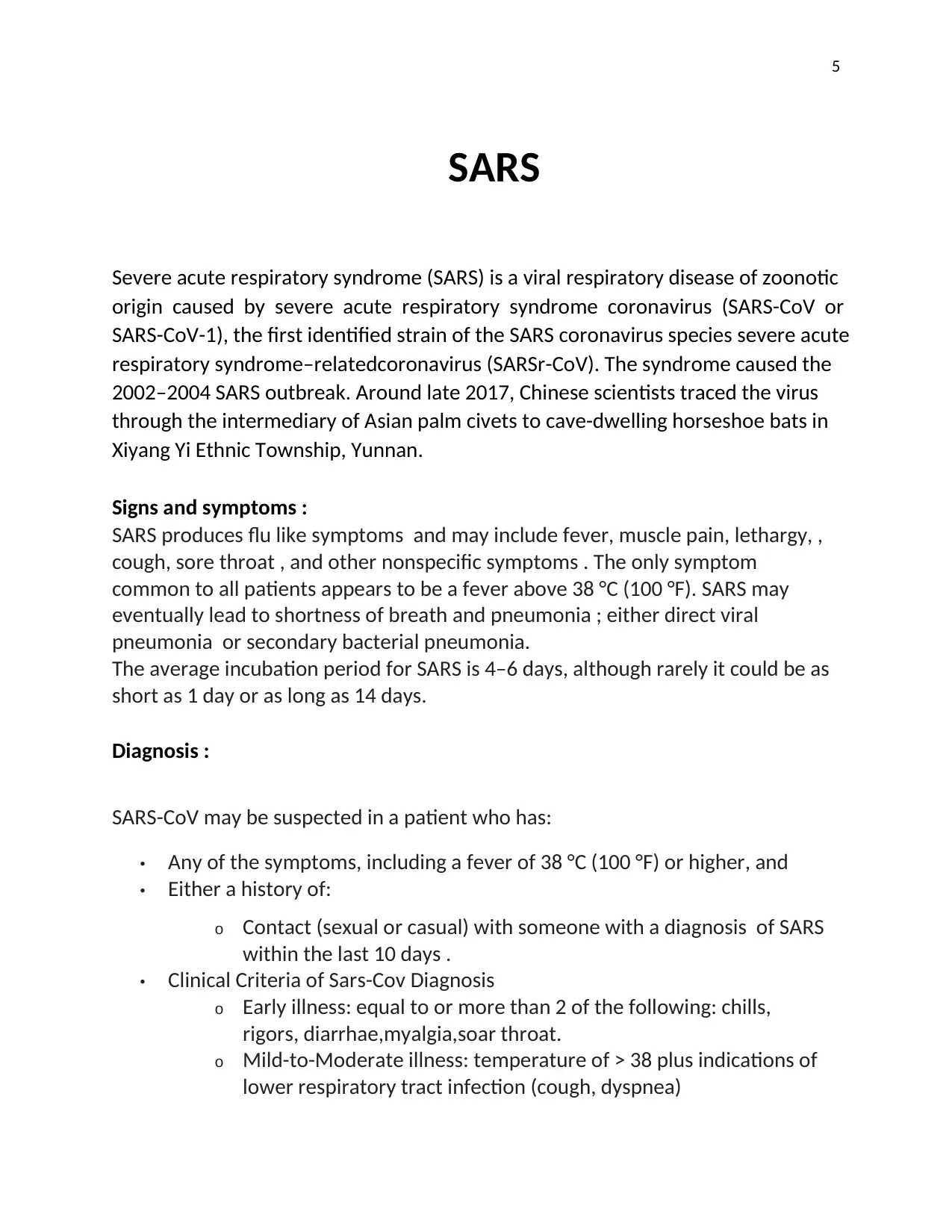
5
SARS
Severe acute respiratory syndrome (SARS) is a viral respiratory disease of zoonotic
origin caused by severe acute respiratory syndrome coronavirus (SARS-CoV or
SARS-CoV-1), the first identified strain of the SARS coronavirus species severe acute
respiratory syndrome–relatedcoronavirus (SARSr-CoV). The syndrome caused the
2002–2004 SARS outbreak. Around late 2017, Chinese scientists traced the virus
through the intermediary of Asian palm civets to cave-dwelling horseshoe bats in
Xiyang Yi Ethnic Township, Yunnan.
Signs and symptoms :
SARS produces flu like symptoms and may include fever, muscle pain, lethargy, ,
cough, sore throat , and other nonspecific symptoms . The only symptom
common to all patients appears to be a fever above 38 °C (100 °F). SARS may
eventually lead to shortness of breath and pneumonia ; either direct viral
pneumonia or secondary bacterial pneumonia.
The average incubation period for SARS is 4–6 days, although rarely it could be as
short as 1 day or as long as 14 days.
Diagnosis :
SARS-CoV may be suspected in a patient who has:
• Any of the symptoms, including a fever of 38 °C (100 °F) or higher, and
• Either a history of:
o Contact (sexual or casual) with someone with a diagnosis of SARS
within the last 10 days .
• Clinical Criteria of Sars-Cov Diagnosis
o Early illness: equal to or more than 2 of the following: chills,
rigors, diarrhae,myalgia,soar throat.
o Mild-to-Moderate illness: temperature of > 38 plus indications of
lower respiratory tract infection (cough, dyspnea)
SARS
Severe acute respiratory syndrome (SARS) is a viral respiratory disease of zoonotic
origin caused by severe acute respiratory syndrome coronavirus (SARS-CoV or
SARS-CoV-1), the first identified strain of the SARS coronavirus species severe acute
respiratory syndrome–relatedcoronavirus (SARSr-CoV). The syndrome caused the
2002–2004 SARS outbreak. Around late 2017, Chinese scientists traced the virus
through the intermediary of Asian palm civets to cave-dwelling horseshoe bats in
Xiyang Yi Ethnic Township, Yunnan.
Signs and symptoms :
SARS produces flu like symptoms and may include fever, muscle pain, lethargy, ,
cough, sore throat , and other nonspecific symptoms . The only symptom
common to all patients appears to be a fever above 38 °C (100 °F). SARS may
eventually lead to shortness of breath and pneumonia ; either direct viral
pneumonia or secondary bacterial pneumonia.
The average incubation period for SARS is 4–6 days, although rarely it could be as
short as 1 day or as long as 14 days.
Diagnosis :
SARS-CoV may be suspected in a patient who has:
• Any of the symptoms, including a fever of 38 °C (100 °F) or higher, and
• Either a history of:
o Contact (sexual or casual) with someone with a diagnosis of SARS
within the last 10 days .
• Clinical Criteria of Sars-Cov Diagnosis
o Early illness: equal to or more than 2 of the following: chills,
rigors, diarrhae,myalgia,soar throat.
o Mild-to-Moderate illness: temperature of > 38 plus indications of
lower respiratory tract infection (cough, dyspnea)
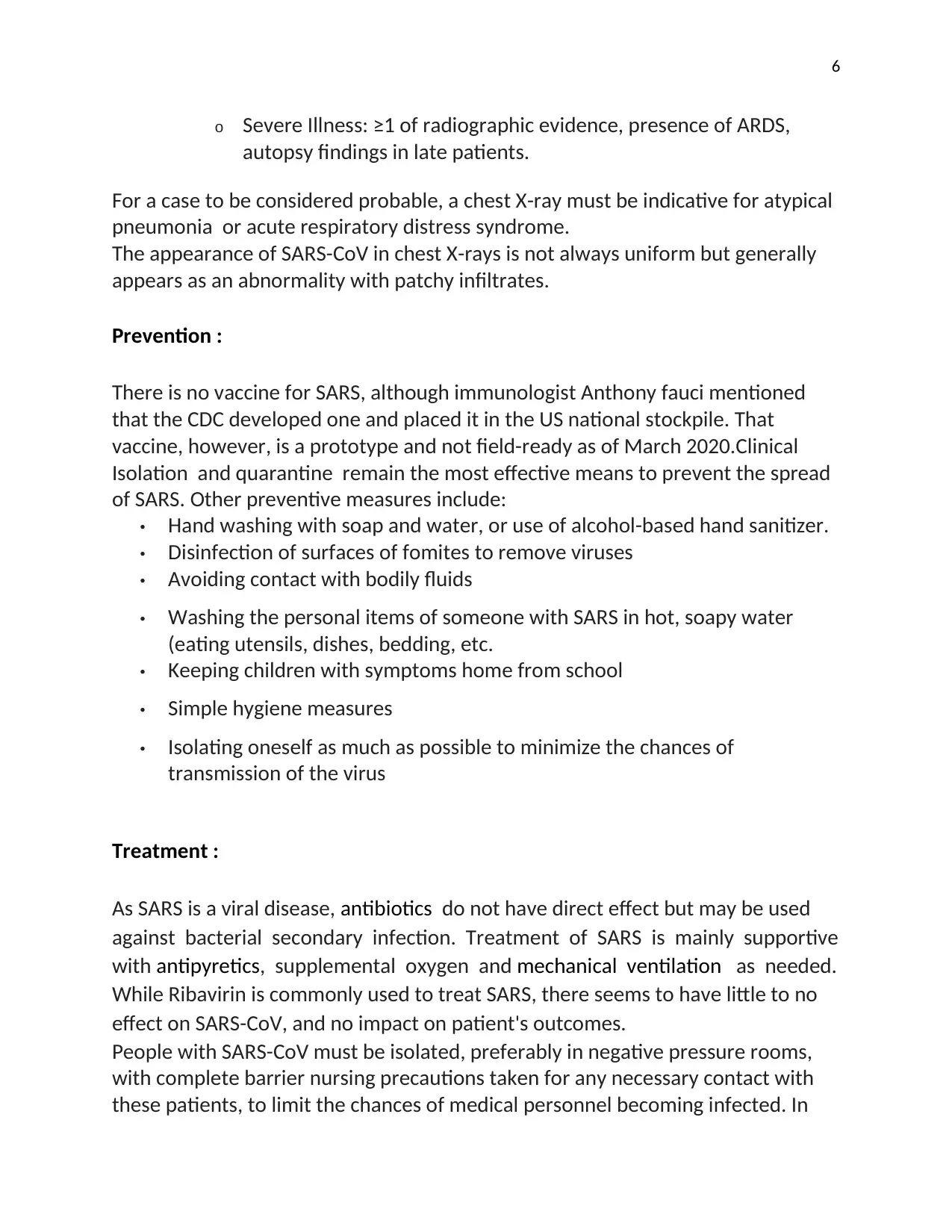
6
o Severe Illness: ≥1 of radiographic evidence, presence of ARDS,
autopsy findings in late patients.
For a case to be considered probable, a chest X-ray must be indicative for atypical
pneumonia or acute respiratory distress syndrome.
The appearance of SARS-CoV in chest X-rays is not always uniform but generally
appears as an abnormality with patchy infiltrates.
Prevention :
There is no vaccine for SARS, although immunologist Anthony fauci mentioned
that the CDC developed one and placed it in the US national stockpile. That
vaccine, however, is a prototype and not field-ready as of March 2020.Clinical
Isolation and quarantine remain the most effective means to prevent the spread
of SARS. Other preventive measures include:
• Hand washing with soap and water, or use of alcohol-based hand sanitizer.
• Disinfection of surfaces of fomites to remove viruses
• Avoiding contact with bodily fluids
• Washing the personal items of someone with SARS in hot, soapy water
(eating utensils, dishes, bedding, etc.
• Keeping children with symptoms home from school
• Simple hygiene measures
• Isolating oneself as much as possible to minimize the chances of
transmission of the virus
Treatment :
As SARS is a viral disease, antibiotics do not have direct effect but may be used
against bacterial secondary infection. Treatment of SARS is mainly supportive
with antipyretics, supplemental oxygen and mechanical ventilation as needed.
While Ribavirin is commonly used to treat SARS, there seems to have little to no
effect on SARS-CoV, and no impact on patient's outcomes.
People with SARS-CoV must be isolated, preferably in negative pressure rooms,
with complete barrier nursing precautions taken for any necessary contact with
these patients, to limit the chances of medical personnel becoming infected. In
o Severe Illness: ≥1 of radiographic evidence, presence of ARDS,
autopsy findings in late patients.
For a case to be considered probable, a chest X-ray must be indicative for atypical
pneumonia or acute respiratory distress syndrome.
The appearance of SARS-CoV in chest X-rays is not always uniform but generally
appears as an abnormality with patchy infiltrates.
Prevention :
There is no vaccine for SARS, although immunologist Anthony fauci mentioned
that the CDC developed one and placed it in the US national stockpile. That
vaccine, however, is a prototype and not field-ready as of March 2020.Clinical
Isolation and quarantine remain the most effective means to prevent the spread
of SARS. Other preventive measures include:
• Hand washing with soap and water, or use of alcohol-based hand sanitizer.
• Disinfection of surfaces of fomites to remove viruses
• Avoiding contact with bodily fluids
• Washing the personal items of someone with SARS in hot, soapy water
(eating utensils, dishes, bedding, etc.
• Keeping children with symptoms home from school
• Simple hygiene measures
• Isolating oneself as much as possible to minimize the chances of
transmission of the virus
Treatment :
As SARS is a viral disease, antibiotics do not have direct effect but may be used
against bacterial secondary infection. Treatment of SARS is mainly supportive
with antipyretics, supplemental oxygen and mechanical ventilation as needed.
While Ribavirin is commonly used to treat SARS, there seems to have little to no
effect on SARS-CoV, and no impact on patient's outcomes.
People with SARS-CoV must be isolated, preferably in negative pressure rooms,
with complete barrier nursing precautions taken for any necessary contact with
these patients, to limit the chances of medical personnel becoming infected. In
⊘ This is a preview!⊘
Do you want full access?
Subscribe today to unlock all pages.

Trusted by 1+ million students worldwide

7
certain cases, natural ventilation by opening doors and windows is documented
to help decreasing indoor concentration of virus particles.
Some of the more serious damage caused by SARS may be due to the body's own
immune system reacting in what is known as cytolin storm.
certain cases, natural ventilation by opening doors and windows is documented
to help decreasing indoor concentration of virus particles.
Some of the more serious damage caused by SARS may be due to the body's own
immune system reacting in what is known as cytolin storm.
Paraphrase This Document
Need a fresh take? Get an instant paraphrase of this document with our AI Paraphraser
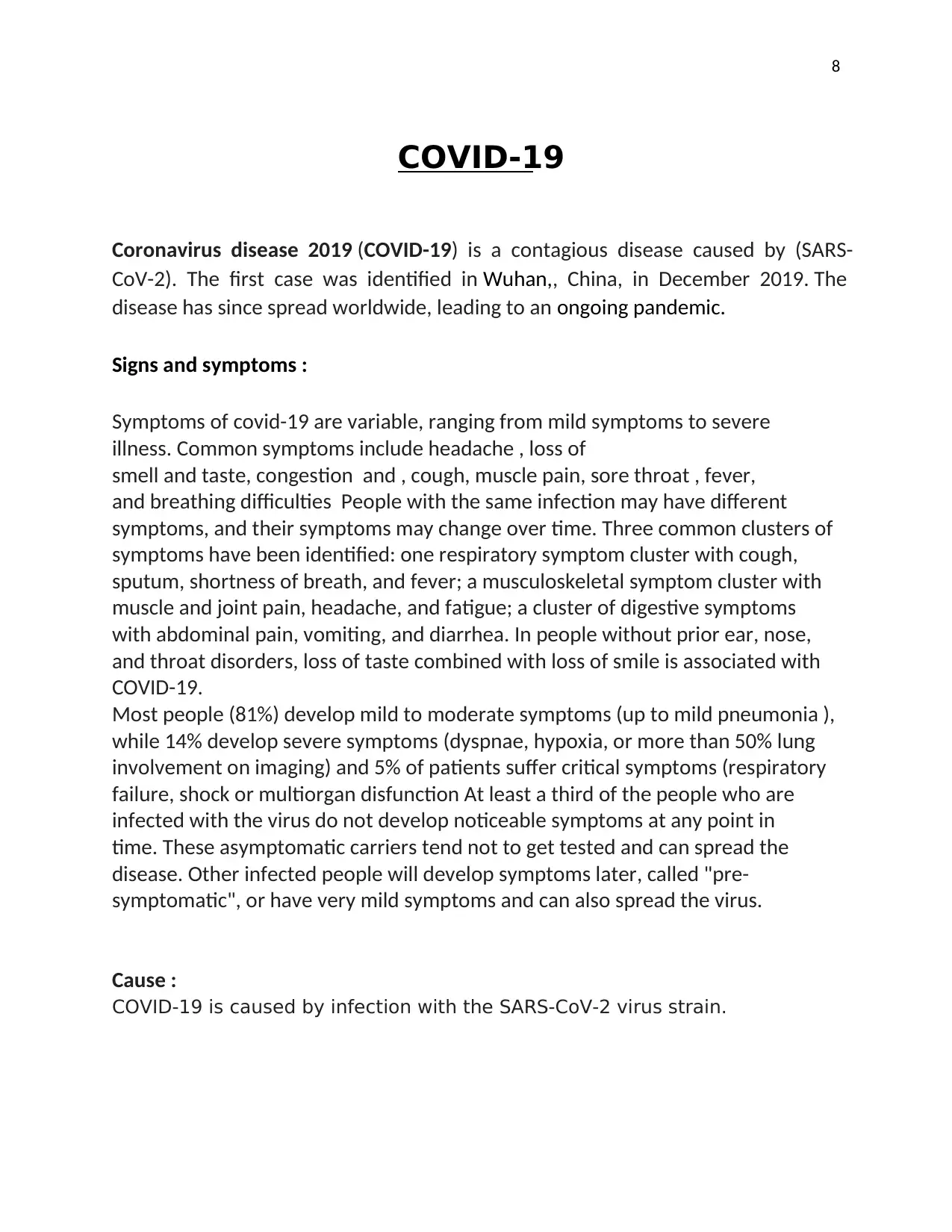
8
COVID-19
Coronavirus disease 2019 (COVID-19) is a contagious disease caused by (SARS-
CoV-2). The first case was identified in Wuhan,, China, in December 2019. The
disease has since spread worldwide, leading to an ongoing pandemic.
Signs and symptoms :
Symptoms of covid-19 are variable, ranging from mild symptoms to severe
illness. Common symptoms include headache , loss of
smell and taste, congestion and , cough, muscle pain, sore throat , fever,
and breathing difficulties People with the same infection may have different
symptoms, and their symptoms may change over time. Three common clusters of
symptoms have been identified: one respiratory symptom cluster with cough,
sputum, shortness of breath, and fever; a musculoskeletal symptom cluster with
muscle and joint pain, headache, and fatigue; a cluster of digestive symptoms
with abdominal pain, vomiting, and diarrhea. In people without prior ear, nose,
and throat disorders, loss of taste combined with loss of smile is associated with
COVID-19.
Most people (81%) develop mild to moderate symptoms (up to mild pneumonia ),
while 14% develop severe symptoms (dyspnae, hypoxia, or more than 50% lung
involvement on imaging) and 5% of patients suffer critical symptoms (respiratory
failure, shock or multiorgan disfunction At least a third of the people who are
infected with the virus do not develop noticeable symptoms at any point in
time. These asymptomatic carriers tend not to get tested and can spread the
disease. Other infected people will develop symptoms later, called "pre-
symptomatic", or have very mild symptoms and can also spread the virus.
Cause :
COVID-19 is caused by infection with the SARS-CoV-2 virus strain.
COVID-19
Coronavirus disease 2019 (COVID-19) is a contagious disease caused by (SARS-
CoV-2). The first case was identified in Wuhan,, China, in December 2019. The
disease has since spread worldwide, leading to an ongoing pandemic.
Signs and symptoms :
Symptoms of covid-19 are variable, ranging from mild symptoms to severe
illness. Common symptoms include headache , loss of
smell and taste, congestion and , cough, muscle pain, sore throat , fever,
and breathing difficulties People with the same infection may have different
symptoms, and their symptoms may change over time. Three common clusters of
symptoms have been identified: one respiratory symptom cluster with cough,
sputum, shortness of breath, and fever; a musculoskeletal symptom cluster with
muscle and joint pain, headache, and fatigue; a cluster of digestive symptoms
with abdominal pain, vomiting, and diarrhea. In people without prior ear, nose,
and throat disorders, loss of taste combined with loss of smile is associated with
COVID-19.
Most people (81%) develop mild to moderate symptoms (up to mild pneumonia ),
while 14% develop severe symptoms (dyspnae, hypoxia, or more than 50% lung
involvement on imaging) and 5% of patients suffer critical symptoms (respiratory
failure, shock or multiorgan disfunction At least a third of the people who are
infected with the virus do not develop noticeable symptoms at any point in
time. These asymptomatic carriers tend not to get tested and can spread the
disease. Other infected people will develop symptoms later, called "pre-
symptomatic", or have very mild symptoms and can also spread the virus.
Cause :
COVID-19 is caused by infection with the SARS-CoV-2 virus strain.
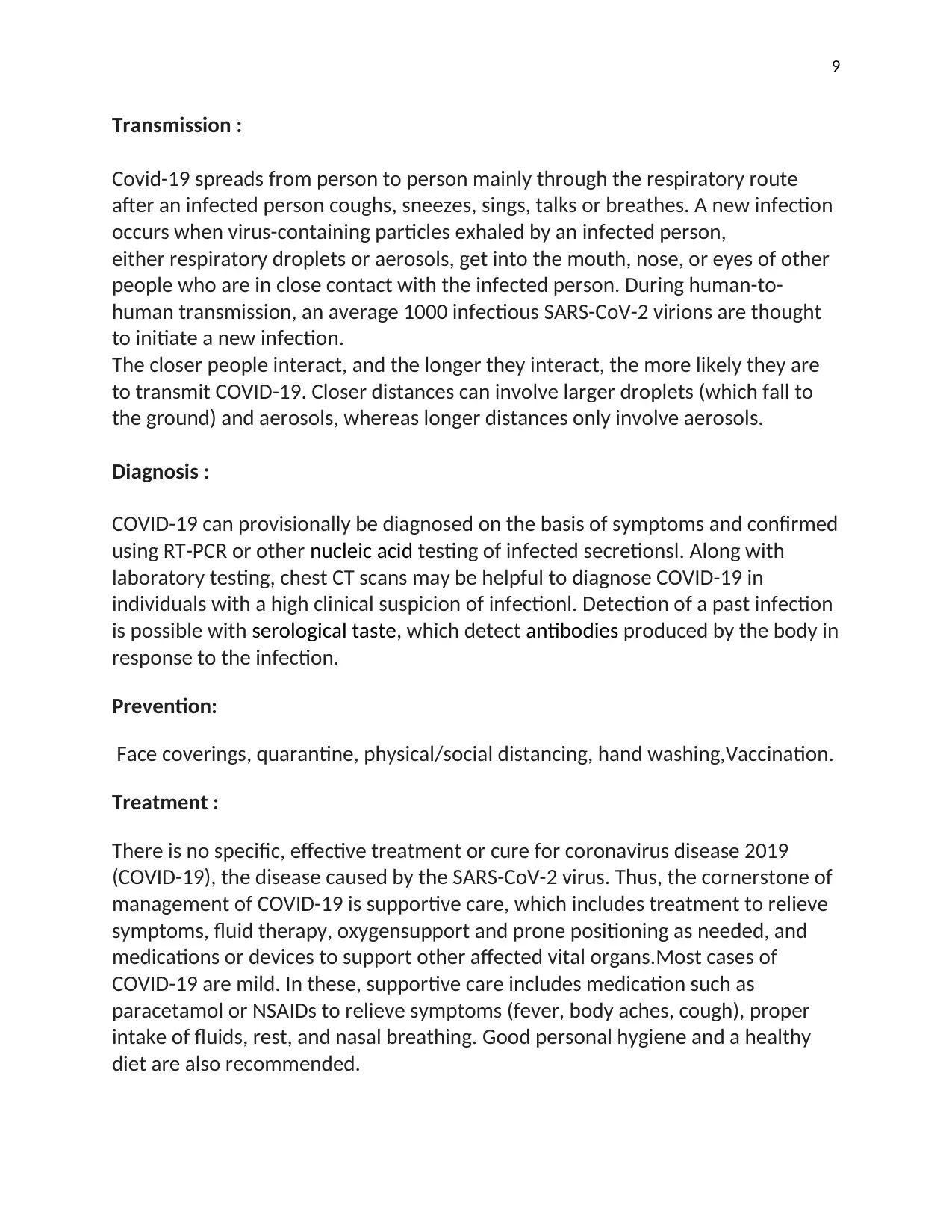
9
Transmission :
Covid-19 spreads from person to person mainly through the respiratory route
after an infected person coughs, sneezes, sings, talks or breathes. A new infection
occurs when virus-containing particles exhaled by an infected person,
either respiratory droplets or aerosols, get into the mouth, nose, or eyes of other
people who are in close contact with the infected person. During human-to-
human transmission, an average 1000 infectious SARS-CoV-2 virions are thought
to initiate a new infection.
The closer people interact, and the longer they interact, the more likely they are
to transmit COVID-19. Closer distances can involve larger droplets (which fall to
the ground) and aerosols, whereas longer distances only involve aerosols.
Diagnosis :
COVID-19 can provisionally be diagnosed on the basis of symptoms and confirmed
using RT-PCR or other nucleic acid testing of infected secretionsl. Along with
laboratory testing, chest CT scans may be helpful to diagnose COVID-19 in
individuals with a high clinical suspicion of infectionl. Detection of a past infection
is possible with serological taste, which detect antibodies produced by the body in
response to the infection.
Prevention:
Face coverings, quarantine, physical/social distancing, hand washing,Vaccination.
Treatment :
There is no specific, effective treatment or cure for coronavirus disease 2019
(COVID-19), the disease caused by the SARS-CoV-2 virus. Thus, the cornerstone of
management of COVID-19 is supportive care, which includes treatment to relieve
symptoms, fluid therapy, oxygensupport and prone positioning as needed, and
medications or devices to support other affected vital organs.Most cases of
COVID-19 are mild. In these, supportive care includes medication such as
paracetamol or NSAIDs to relieve symptoms (fever, body aches, cough), proper
intake of fluids, rest, and nasal breathing. Good personal hygiene and a healthy
diet are also recommended.
Transmission :
Covid-19 spreads from person to person mainly through the respiratory route
after an infected person coughs, sneezes, sings, talks or breathes. A new infection
occurs when virus-containing particles exhaled by an infected person,
either respiratory droplets or aerosols, get into the mouth, nose, or eyes of other
people who are in close contact with the infected person. During human-to-
human transmission, an average 1000 infectious SARS-CoV-2 virions are thought
to initiate a new infection.
The closer people interact, and the longer they interact, the more likely they are
to transmit COVID-19. Closer distances can involve larger droplets (which fall to
the ground) and aerosols, whereas longer distances only involve aerosols.
Diagnosis :
COVID-19 can provisionally be diagnosed on the basis of symptoms and confirmed
using RT-PCR or other nucleic acid testing of infected secretionsl. Along with
laboratory testing, chest CT scans may be helpful to diagnose COVID-19 in
individuals with a high clinical suspicion of infectionl. Detection of a past infection
is possible with serological taste, which detect antibodies produced by the body in
response to the infection.
Prevention:
Face coverings, quarantine, physical/social distancing, hand washing,Vaccination.
Treatment :
There is no specific, effective treatment or cure for coronavirus disease 2019
(COVID-19), the disease caused by the SARS-CoV-2 virus. Thus, the cornerstone of
management of COVID-19 is supportive care, which includes treatment to relieve
symptoms, fluid therapy, oxygensupport and prone positioning as needed, and
medications or devices to support other affected vital organs.Most cases of
COVID-19 are mild. In these, supportive care includes medication such as
paracetamol or NSAIDs to relieve symptoms (fever, body aches, cough), proper
intake of fluids, rest, and nasal breathing. Good personal hygiene and a healthy
diet are also recommended.
⊘ This is a preview!⊘
Do you want full access?
Subscribe today to unlock all pages.

Trusted by 1+ million students worldwide
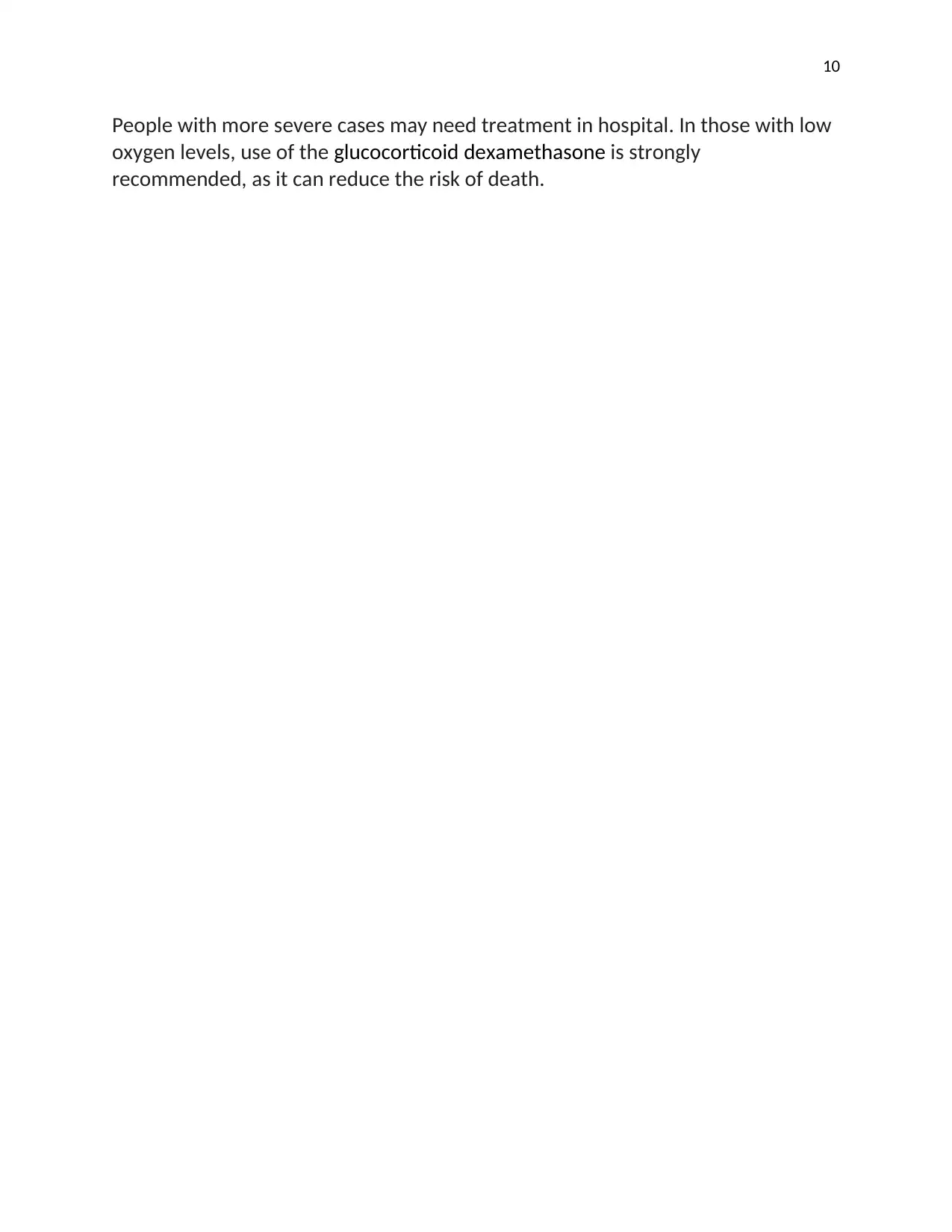
10
People with more severe cases may need treatment in hospital. In those with low
oxygen levels, use of the glucocorticoid dexamethasone is strongly
recommended, as it can reduce the risk of death.
People with more severe cases may need treatment in hospital. In those with low
oxygen levels, use of the glucocorticoid dexamethasone is strongly
recommended, as it can reduce the risk of death.
1 out of 10
Related Documents
Your All-in-One AI-Powered Toolkit for Academic Success.
+13062052269
info@desklib.com
Available 24*7 on WhatsApp / Email
![[object Object]](/_next/static/media/star-bottom.7253800d.svg)
Unlock your academic potential
Copyright © 2020–2025 A2Z Services. All Rights Reserved. Developed and managed by ZUCOL.





